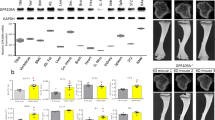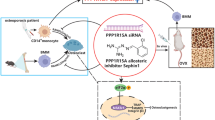Abstract
Background
It was recently reported that G protein-coupled receptor 65 (GPR65) suppresses ovariectomy-induced bone loss.
Aim
The present study investigated the role of the lysosphingolipid psychosine, a GPR65 ligand, on osteoclastic differentiation and bone resorption.
Methods
Osteoclasts were differentiated from mouse bone marrow macrophages. Tartrate-resistant acid phosphatase-positive multinucleated cells were considered to be osteoclasts, and the resorption area was measured by incubating the cells on dentine discs. The expression levels of osteoclast differentiation markers were assessed by qRT-PCR. GPR65 siRNA and its scrambled siRNA were transfected with lipofectamine. Intracellular cyclic adenosine monophosphate (cAMP) levels were assessed using a direct enzyme immunoassay.
Results
Psychosine inhibited osteoclastogenesis and in vitro bone resorption without any significant effect on the viability of pre-osteoclasts, decreased the expression of osteoclast differentiation markers significantly, and increased intracellular cAMP levels. The knockdown of GPR65 by its siRNA restored osteoclastogenesis and decreased cAMP levels in the presence of psychosine.
Conclusion
Psychosine inhibits osteoclastogenesis by increasing intracellular cAMP levels via GPR65.




Similar content being viewed by others
References
(1993) Consensus development conference: diagnosis, prophylaxis, and treatment of osteoporosis. Am J Med 94:646–650
Pierce KL, Premont RT, Lefkowitz RJ (2002) Seven-transmembrane receptors. Nat Rev Mol Cell Biol 3:639–650. doi:10.1038/nrm908
Juppner H (1994) Molecular cloning and characterization of a parathyroid hormone/parathyroid hormone-related peptide receptor: a member of an ancient family of G protein-coupled receptors. Curr Opin Nephrol Hypertens 3:371–378
Purdue BW, Tilakaratne N, Sexton PM (2002) Molecular pharmacology of the calcitonin receptor. Recept Channels 8:243–255
D’Souza-Li L (2006) The calcium-sensing receptor and related diseases. Arq Bras Endocrinol Metabol 50:628–639
Tomura H, Mogi C, Sato K, Okajima F (2005) Proton-sensing and lysolipid-sensitive G-protein-coupled receptors: a novel type of multi-functional receptors. Cell Signal 17:1466–1476. doi:10.1016/j.cellsig.2005.06.002
Im DS, Heise CE, Nguyen T, O’Dowd BF, Lynch KR (2001) Identification of a molecular target of psychosine and its role in globoid cell formation. J Cell Biol 153:429–434
Hikiji H, Endo D, Horie K, Harayama T, Akahoshi N, Igarashi H, Kihara Y, Yanagida K, Takeda J, Koji T, Shimizu T, Ishii S (2014) TDAG8 activation inhibits osteoclastic bone resorption. FASEB J 28:871–879. doi:10.1096/fj.13-233106
Wang JQ, Kon J, Mogi C, Tobo M, Damirin A, Sato K, Komachi M, Malchinkhuu E, Murata N, Kimura T, Kuwabara A, Wakamatsu K, Koizumi H, Uede T, Tsujimoto G, Kurose H, Sato T, Harada A, Misawa N, Tomura H, Okajima F (2004) TDAG8 is a proton-sensing and psychosine-sensitive G-protein-coupled receptor. J Biol Chem 279:45626–45633. doi:10.1074/jbc.M406966200
Ishii S, Kihara Y, Shimizu T (2005) Identification of T cell death-associated gene 8 (TDAG8) as a novel acid sensing G-protein-coupled receptor. J Biol Chem 280:9083–9087. doi:10.1074/jbc.M407832200
Seuwen K, Ludwig MG, Wolf RM (2006) Receptors for protons or lipid messengers or both? J Recept Signal Transduct Res 26:599–610. doi:10.1080/10799890600932220
Meyer zu Heringdorf D, Jakobs KH (2007) Lysophospholipid receptors: signalling, pharmacology and regulation by lysophospholipid metabolism. Biochim Biophys Acta 1768:923–940. doi:10.1016/j.bbamem.2006.09.026
Yoon SH, Ryu J, Lee Y, Lee ZH, Kim HH (2011) Adenylate cyclase and calmodulin-dependent kinase have opposite effects on osteoclastogenesis by regulating the PKA-NFATc1 pathway. J Bone Miner Res 26:1217–1229. doi:10.1002/jbmr.310
Suzuki K (1998) Twenty five years of the “psychosine hypothesis”: a personal perspective of its history and present status. Neurochem Res 23:251–259
Mun SH, Won HY, Hernandez P, Aguila HL, Lee SK (2013) Deletion of CD74, a putative MIF receptor, in mice enhances osteoclastogenesis and decreases bone mass. J Bone Miner Res 28:948–959. doi:10.1002/jbmr.1787
Lee SK, Gardner AE, Kalinowski JF, Jastrzebski SL, Lorenzo JA (2006) RANKL-stimulated osteoclast-like cell formation in vitro is partially dependent on endogenous interleukin-1 production. Bone 38:678–685. doi:10.1016/j.bone.2005.10.011
Boyle WJ, Simonet WS, Lacey DL (2003) Osteoclast differentiation and activation. Nature 423:337–342. doi:10.1038/nature01658
Sato K, Suematsu A, Nakashima T, Takemoto-Kimura S, Aoki K, Morishita Y, Asahara H, Ohya K, Yamaguchi A, Takai T, Kodama T, Chatila TA, Bito H, Takayanagi H (2006) Regulation of osteoclast differentiation and function by the CaMK-CREB pathway. Nat Med 12:1410–1416. doi:10.1038/nm1515
Whyte LS, Ryberg E, Sims NA, Ridge SA, Mackie K, Greasley PJ, Ross RA, Rogers MJ (2009) The putative cannabinoid receptor GPR55 affects osteoclast function in vitro and bone mass in vivo. Proc Natl Acad Sci USA 106:16511–16516. doi:10.1073/pnas.0902743106
Wauquier F, Philippe C, Leotoing L, Mercier S, Davicco MJ, Lebecque P, Guicheux J, Pilet P, Miot-Noirault E, Poitout V, Alquier T, Coxam V, Wittrant Y (2013) The free fatty acid receptor G protein-coupled receptor 40 (GPR40) protects from bone loss through inhibition of osteoclast differentiation. J Biol Chem 288:6542–6551. doi:10.1074/jbc.M112.429084
Iwai K, Koike M, Ohshima S, Miyatake K, Uchiyama Y, Saeki Y, Ishii M (2007) RGS18 acts as a negative regulator of osteoclastogenesis by modulating the acid-sensing OGR1/NFAT signaling pathway. J Bone Miner Res 22:1612–1620. doi:10.1359/jbmr.070612
Pereverzev A, Komarova SV, Korcok J, Armstrong S, Tremblay GB, Dixon SJ, Sims SM (2008) Extracellular acidification enhances osteoclast survival through an NFAT-independent, protein kinase C-dependent pathway. Bone 42:150–161. doi:10.1016/j.bone.2007.08.044
Yang M, Mailhot G, Birnbaum MJ, MacKay CA, Mason-Savas A, Odgren PR (2006) Expression of and role for ovarian cancer G-protein-coupled receptor 1 (OGR1) during osteoclastogenesis. J Biol Chem 281:23598–23605. doi:10.1074/jbc.M602191200
Kottyan LC, Collier AR, Cao KH, Niese KA, Hedgebeth M, Radu CG, Witte ON, Khurana Hershey GK, Rothenberg ME, Zimmermann N (2009) Eosinophil viability is increased by acidic pH in a cAMP- and GPR65-dependent manner. Blood 114:2774–2782. doi:10.1182/blood-2009-05-220681
Sheridan CM, Heist EK, Beals CR, Crabtree GR, Gardner P (2002) Protein kinase A negatively modulates the nuclear accumulation of NF-ATc1 by priming for subsequent phosphorylation by glycogen synthase kinase-3. J Biol Chem 277:48664–48676. doi:10.1074/jbc.M207029200
Kim BJ, Lee YS, Lee SY, Park SY, Dieplinger H, Yea K, Lee SH, Koh JM, Kim GS (2013) Afamin stimulates osteoclastogenesis and bone resorption via Gi-coupled receptor and Ca2+/calmodulin-dependent protein kinase (CaMK) pathways. J Endocrinol Invest 36:876–882. doi:10.3275/8975
Robison GA, Butcher RW, Sutherland EW (1968) Cyclic AMP. Annu Rev Biochem 37:149–174. doi:10.1146/annurev.bi.37.070168.001053
Duffner PK, Barczykowski A, Jalal K, Yan L, Kay DM, Carter RL (2011) Early infantile Krabbe disease: results of the World-Wide Krabbe Registry. Pediatr Neurol 45:141–148. doi:10.1016/j.pediatrneurol.2011.05.007
Suzuki K (2003) Globoid cell leukodystrophy (Krabbe’s disease): update. J Child Neurol 18:595–603
Contreras MA, Ries WL, Shanmugarajan S, Arboleda G, Singh I, Singh AK (2010) Factors that affect postnatal bone growth retardation in the twitcher murine model of Krabbe disease. Biochim Biophys Acta 1802:601–608. doi:10.1016/j.bbadis.2010.04.006
Whitfield PD, Sharp PC, Taylor R, Meikle P (2001) Quantification of galactosylsphingosine in the twitcher mouse using electrospray ionization-tandem mass spectrometry. J Lipid Res 42:2092–2095
Nozawa M, Iwamoto T, Tokoro T, Eto Y (1992) Novel procedure for measuring psychosine derivatives by an HPLC method. J Neurochem 59:607–609
Galbiati F, Basso V, Cantuti L, Givogri MI, Lopez-Rosas A, Perez N, Vasu C, Cao H, van Breemen R, Mondino A, Bongarzone ER (2007) Autonomic denervation of lymphoid organs leads to epigenetic immune atrophy in a mouse model of Krabbe disease. J Neurosci 27:13730–13738. doi:10.1523/jneurosci.3379-07.2007
Zhu H, Lopez-Rosas A, Qiu X, Van Breemen RB, Bongarzone ER (2012) Detection of the neurotoxin psychosine in samples of peripheral blood: application in diagnostics and follow-up of Krabbe disease. Arch Pathol Lab Med 136:709–710. doi:10.5858/arpa.2011-0667-LE
Zanfini A, Dreassi E, Berardi A, Governini L, Corbini G, Costantino-Ceccarini E, Balestri P, Luddi A (2013) Quantification of psychosine in the serum of twitcher mouse by LC-ESI-tandem-MS analysis. J Pharm Biomed Anal 80:44–49. doi:10.1016/j.jpba.2013.02.039
Acknowledgments
This study was supported by a grant from the Korea Health Technology R&D project, Ministry of Health and Welfare, Republic of Korea (project No.: HI14C2185) and by a grant from the Asan Institute for Life Sciences, Seoul, Republic of Korea (project No.: 2014-586).
Conflict of interest
The authors declare that they have no conflict of interest.
Ethical approval
This article does not contain any studies with human participants performed by any of the authors. All procedures performed in studies involving animals were approved by the Institutional Animal Care and Use Committee of the Asan Institute for Life Sciences (Seoul, Korea).
Informed consent
No informed consent.
Author information
Authors and Affiliations
Corresponding author
Additional information
S. H. Ahn and S.-Y. Lee contributed equally to this work.
Rights and permissions
About this article
Cite this article
Ahn, S.H., Lee, SY., Baek, JE. et al. Psychosine inhibits osteoclastogenesis and bone resorption via G protein-coupled receptor 65. J Endocrinol Invest 38, 891–899 (2015). https://doi.org/10.1007/s40618-015-0276-9
Received:
Accepted:
Published:
Issue Date:
DOI: https://doi.org/10.1007/s40618-015-0276-9




